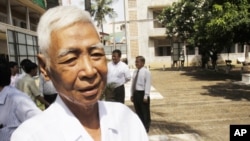Vann Nath, a Khmer Rouge prisoner who survived by painting portraits of Pol Pot, died in Phnom Penh on Monday, following an 11-day coma brought on by a heart attack, family members and health officials said.
Vann Nath, who was born in 1946 into a poor family in Battambang province, survived the Khmer Rouge’s notorious Tuol Sleng prison and had been an ardent supporter of victims’ justice at the UN-backed tribunal.
He served as a witness in Case 001 at the tribunal, which put Kaing Kek Iev, the supervisor of Tuol Sleng prison better known as Duch, on trial for atrocity crimes.
More than 12,000 Cambodians were tortured and sent to their deaths at the prison, known to the Khmer Rouge as S-21. Vann Nath was among seven known Tuol Sleng survivors. He said later he had been spared in order to paint portraits of Pol Pot, and he went on to pen a memoir about his time at the prison.
When Duch was given a commuted sentence of 19 years—a decision that is still under consideration at the tribunal’s Supreme Court Chamber—Vann Nath said he could “accept” the court’s decision.
He died at a local private clinic at 12:45 pm, according to family members. His body was prepared at the clinic and transported to his home in Prampimakara district, Phnom Penh, where it was to be prepared for a seven-day Buddhist ceremony.
His wife, Kit Eng, 62, said she regretted the loss of a “good husband.”
“We always appeared together at the [tribunal] to find justice for victims,” said fellow prison survivor Chhum Mey. “I very much regret losing Vann Nath.”
In peacetime, Vann Nath created indelible images came to characterize the terror of the Khmer Rouge and its policies of torture and imprisonment. His death was deeply felt across the diplomatic and civic community.
In a joint statement, the embassies of France and Japan called him a “tireless freedom fighter” who had preserved the reality of the Khmer Rouge period through his painting and writing.
Huy Vannak, a spokesman for the tribunal, said he personally regretted the passing of Vann Nath before the court was able to reach a final verdict for his captor, Duch. That decision, which includes appeals for his release and for more jail time, is expected later this year.
Lath Ky, a tribunal monitor for the rights group Adhoc, said he felt “very sorry” for Vann Nath’s death, and he urged to court to take it as a message to speed its work, including finding a final verdict for Duch.
“I think Vann Nath’s family, as well as all of the other civil parties and other survivors, want to see a final resolution to the Duch [trial] as very soon as possible,” said Clair Duffy, a court observer for the Open Society Justice Initiative.
His death was also a reminder of the age and poor health of four detained regime leaders who have yet to be tried, said Chhang Youk, director of the Documentation Center of Cambodia.
Government spokesman Phay Siphan said Monday Vann Nath’s death meant the loss of a “living witness” to Khmer Rouge atrocities who had made “important contributions to the dispensation of justice.”




